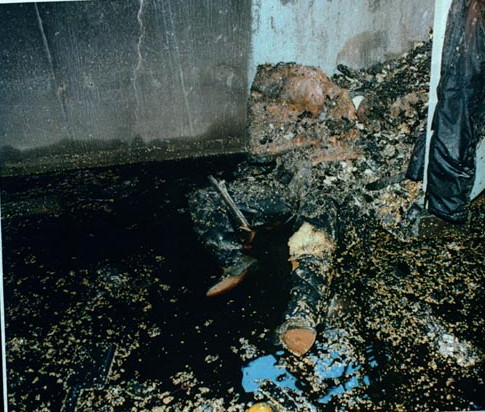
RCMP INVESTIGATION
Leon had told police that Cori had driven her car into the house and swung a hockey stick at him, hitting him on the side of the head. A struggle ensued and Leon tried to get away from her. He tried getting into the house, to call for help, and was either pushed, or fell down the basement stairs. He believes he was knocked out for a few minutes or seconds. When he woke up, Cori was standing in front of him and was going to strike him with the stick. He moved his head out of the way and the stick hit the wall and broke. Cori then tried to "spear" him with the broken part of the stick, which is how the puncture wound under his eye occurred. Leon tried to get the stick away from her and both of them were struggling on the basement floor. Leon then heard the smoke detector and smelled smoke. He tried to get up and go upstairs to see what was happening. Cori grabbed him around the ankles and pulled him down. While doing this, she had let go of the hockey stick. Leon then picked up the stick and hit her until she let go of his ankles. He threw the stick and remembers hearing it either hit the furnace or the duct work. He continued up the stairs and turned to she if she was following. At this time she was getting up off of the floor. Leon then tried to put out the fire, which was burning the porch wall beside the car, with the use of his jacket. The jacket soon caught on fire, and he ran to his truck to get his cell phone. He called his mother and asked her to call the fire department. (There is no 911 service) Leon went back around the house and heard Cori screaming and crying for help. He tried to re-enter the house, but there was too much fire, smoke, and heat.
It does not take much time to be overcome by the smoke. An example of this is just this year in Regina SK, a man called 911 from inside his burning home. It took six minutes for the fire rescue crews to respond. The man lived across the street from the hospital, and yet he did not survive. He was overcome by smoke and carbon monoxide.
The RCMP's initial theory was that Leon had shot Cori and started the house on fire to cover up evidence. There were two firearms experts present for the autopsy. Why? Is it standard procedure to have firearms experts present at all autopsies? Or were they sure of finding a bullet?
The RCMP knew that a hockey stick was part of the investigation on March 30, 1998, because Leon had told, not only the investigating officers, but also neighbors, his mom, fire personal, ambulance attendants, and hospital staff that Cori had attacked him with a hockey stick. Cst Brent Lewis, Sgt Charles Miller, and Cpl Doug Rushleau, three of the RCMP officers that testified, stated they were unaware of a hockey stick being an important part of the investigation until April 1, 1998. The fourth RCMP officer, Cpl Chuck Appleton, testified that they were told at a briefing on March 31, 1998, to look for hockey stick remains. They concluded that a hockey stick was not found in the basement, and that only some pieces of hockey sticks were found in the burned out porch. These were found in the vicinity of where Leon's son's hockey equipment was stored.
When one views the RCMP's own scene photograph, one can clearly see a broken hockey stick lying across Cori's right leg. When the RCMP officers were questioned about this object and whether or not it was seized for evidence, the same three officers testified that they did not recall that object being there. Appleton, testified that he'd seen it, but that it wasn't anything important and may have been a piece of the window frame. Again, one can clearly see that on their scene photos, the window frame is totally intact.

This is what appears to be the hockey stick that was never found. (Above) One can even see that the decal has started peeling and rolling back from the heat and water. (Below) The two white stripes on the decal are also seen.
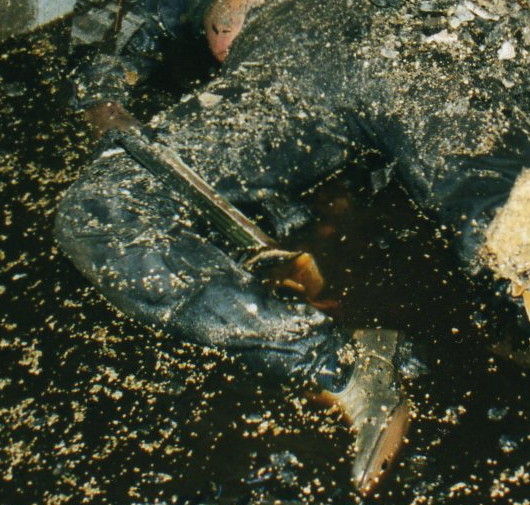
The following photos show views of the window frame. The outside view shows it intact and both inside views show the frame intact.
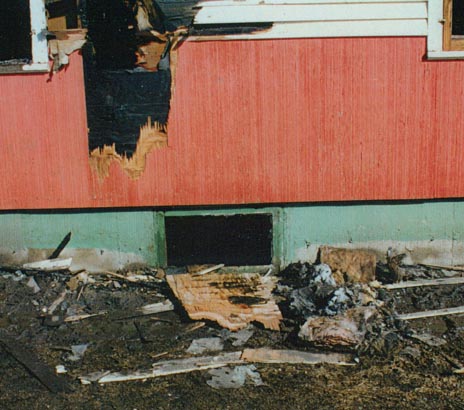
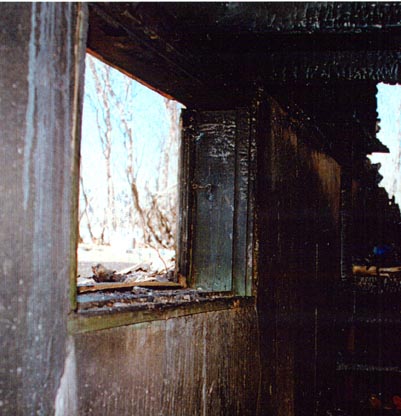
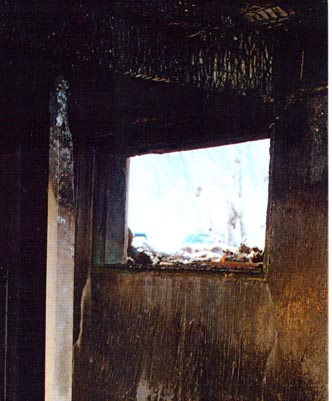
The photographing sequence of the body doesn't make sense either. The officers stated in court that photos where taken, then some debris was removed from the body, then photos where take, then debris removed etc. But when you look at the photos, they don't make sense. One photo is the first one show on this page, then there is one exactly the same, but the stick has been removed, then there is one when her chest and face has been uncovered and the stick is again present. The only way that is possible is if the stick was removed and then put back.
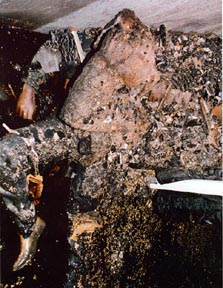
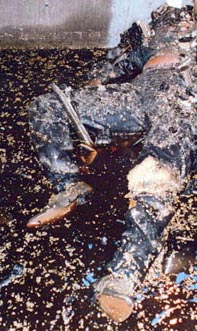
The photo on the left shows that the chest and face are still covered with debris and the stick has been removed. The photo on the right shows that now the chest and face has been uncovered and the stick is back. (out of respect for Cori, I cropped her face, but you can still notice the chest area) NOW YOU SEE IT, NOW YOU DON'T, NOW YOU SEE IT.
Why was the stick not seized as evidence? The hockey stick was a key to help Leon in proving his innocence. It would have proved that Cori was not unconscious when Leon went upstairs. Because she went to retrieve the stick from where Leon had threw it, she wasted the precious few moments needed to escape a fire. Her fingerprints would have been found on the stick and most likely some of Leon's blood. Since those findings would have collaborated his version of the events, Leon believes that is the reason why the hockey stick was "never found".
The RCMP concluded that Leon started the fire because he didn't smoke, and they found a book of wedding matches in his pants . Leon lived on a farm and anyone who has lived on a farm knows that garbage is usually burned. That's what he had been doing the day before and he told police that. He also told them that he had found two cases of left over wedding matches and decided to use them up. He then told them that there was another case and a half of matches in the basement. Those matches were never produced in evidence, but are missing from Leon's home. He also told the police that he had just spent over $200.00 on groceries that weekend and told them that there was a case of pizza pockets in the deep freeze. These also went "missing" and weren't ever produced as evidence. This food was in the freezer as Leon was teased later on by a fire fighter from the scene about the pizza's and something to the effect of being a bachelor cook. Leon noted a number of other items missing since and yet were not placed in evidence.
The RCMP showed immediate bias toward Leon. Cori was close friends with a number of the local detachment. In fact, her closest companion was Cst. Wayne Dingle, the first RCMP to arrive at the scene. The second officer and arresting officer was Cst. Blaine Oster, another friend of Cori's. Cst. Oster testified at the trial, that Cori had been partying with Dingle the night of March 29, 1998, until the wee hours of the morning. She had also told her cousin this.
Cst. Wayne Dingle was even a pallbearer for Cori.
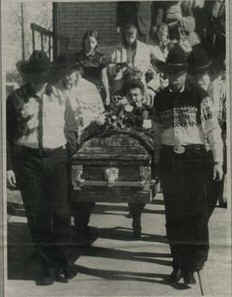
Front right is Cst. Wayne Dingle carrying Cori's coffin. This photo appeared in the local newspaper, the Melville Advance, the week following the funeral. At the time of Cori's death, Dingle was a member of Melville's RCMP detachment.
Leon's story has never changed. The information is supported by the evidence found, yet Leon believes that the investigators did all they could to twist and manipulate the physical evidence to try and use it against him and what ever didn't fit there theory, disappeared. He has always told the same version of events despite days of intense questioning. An undercover cop, posing as someone having been arrested for drug possession, reported that Leon told him the same story.